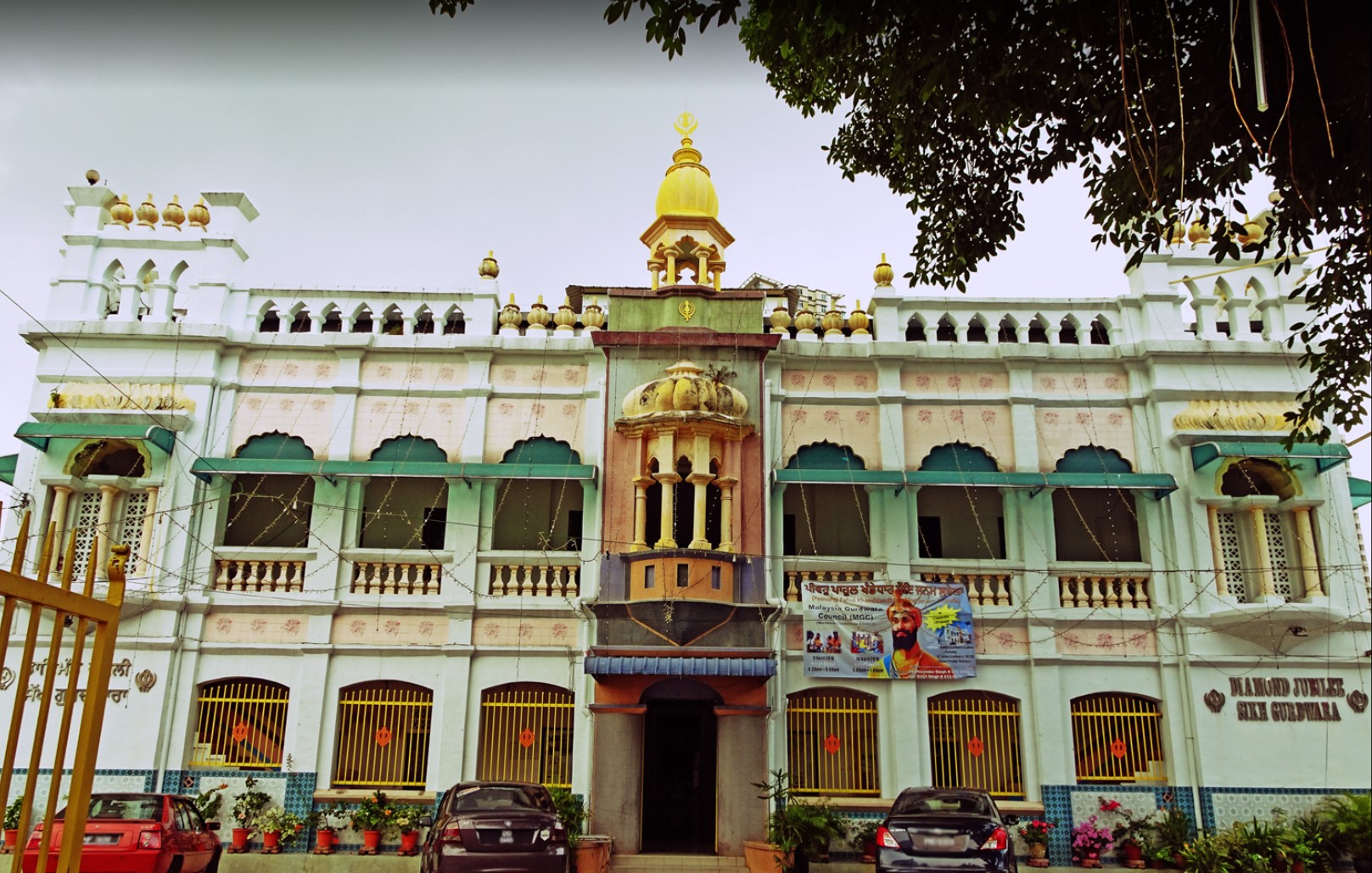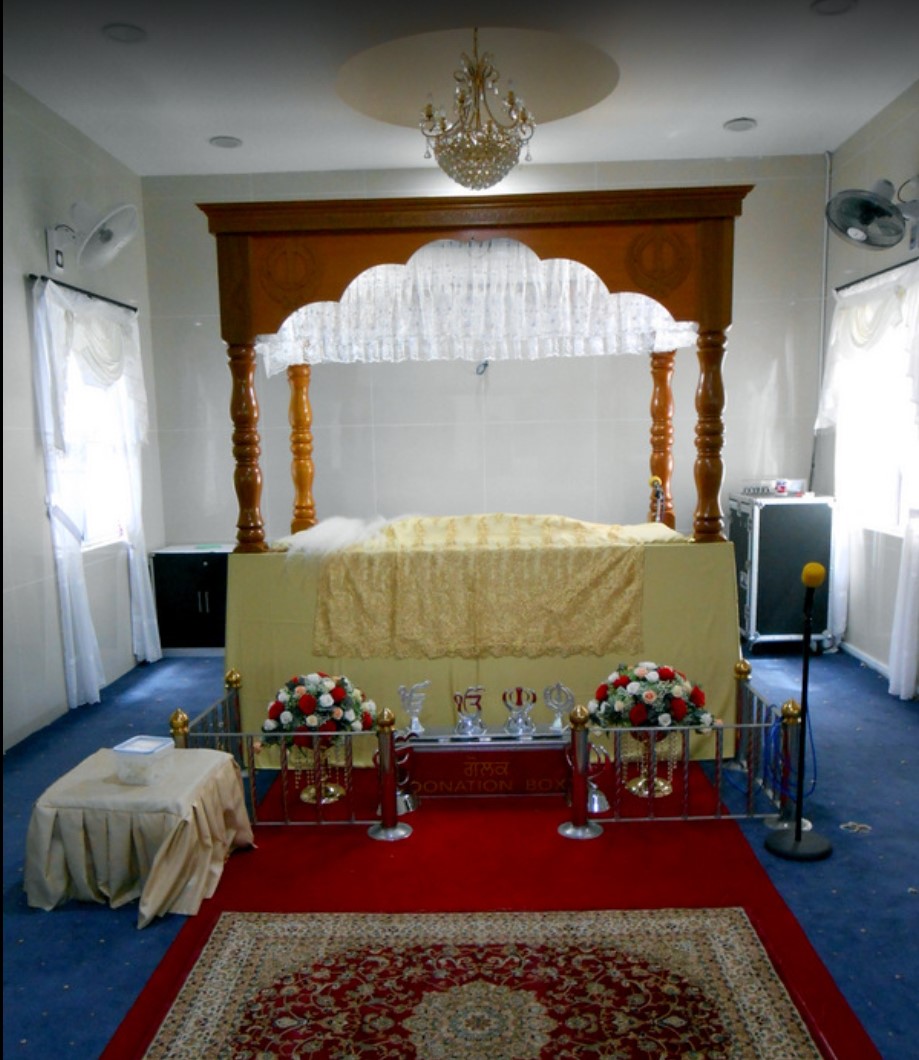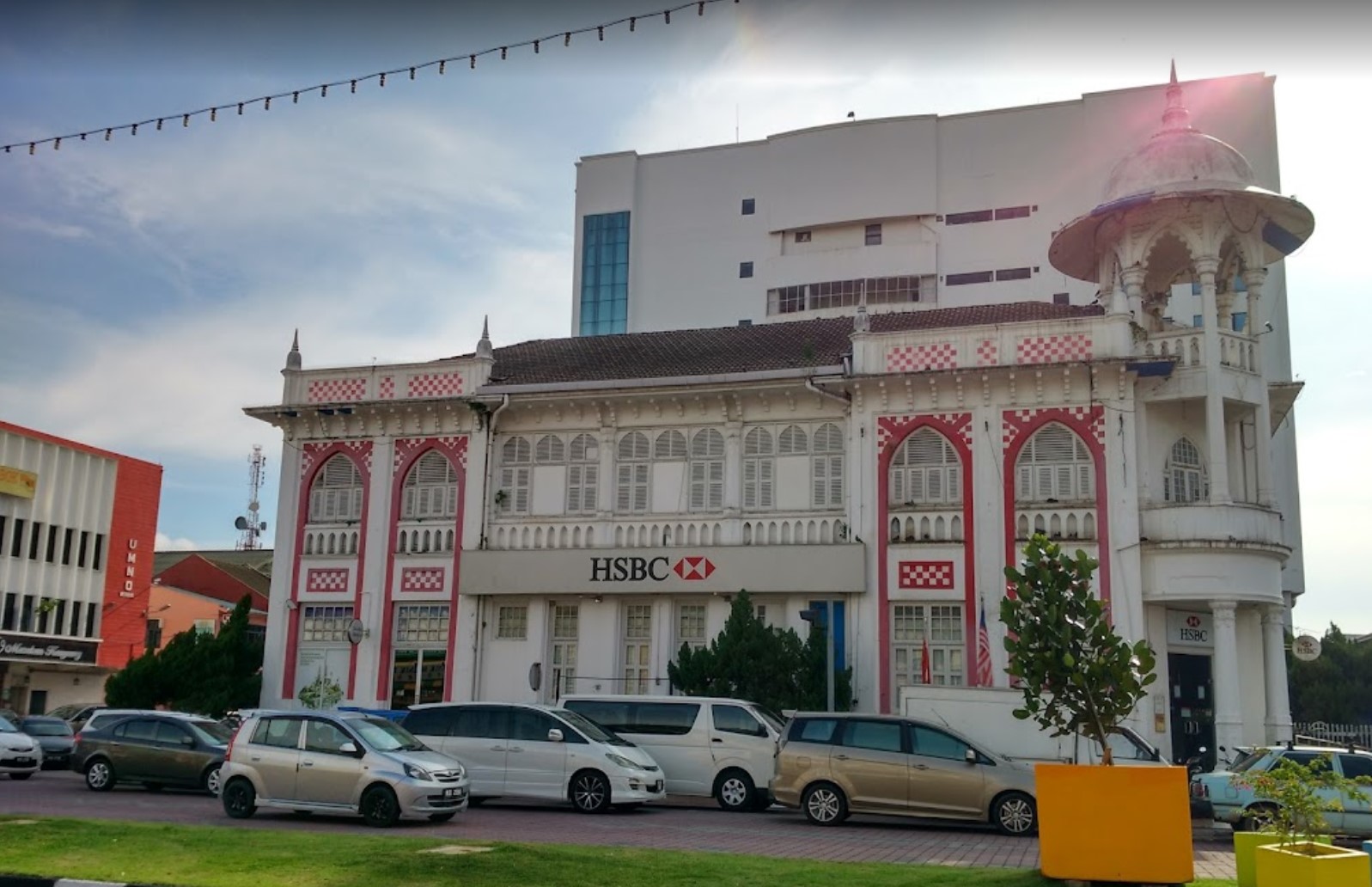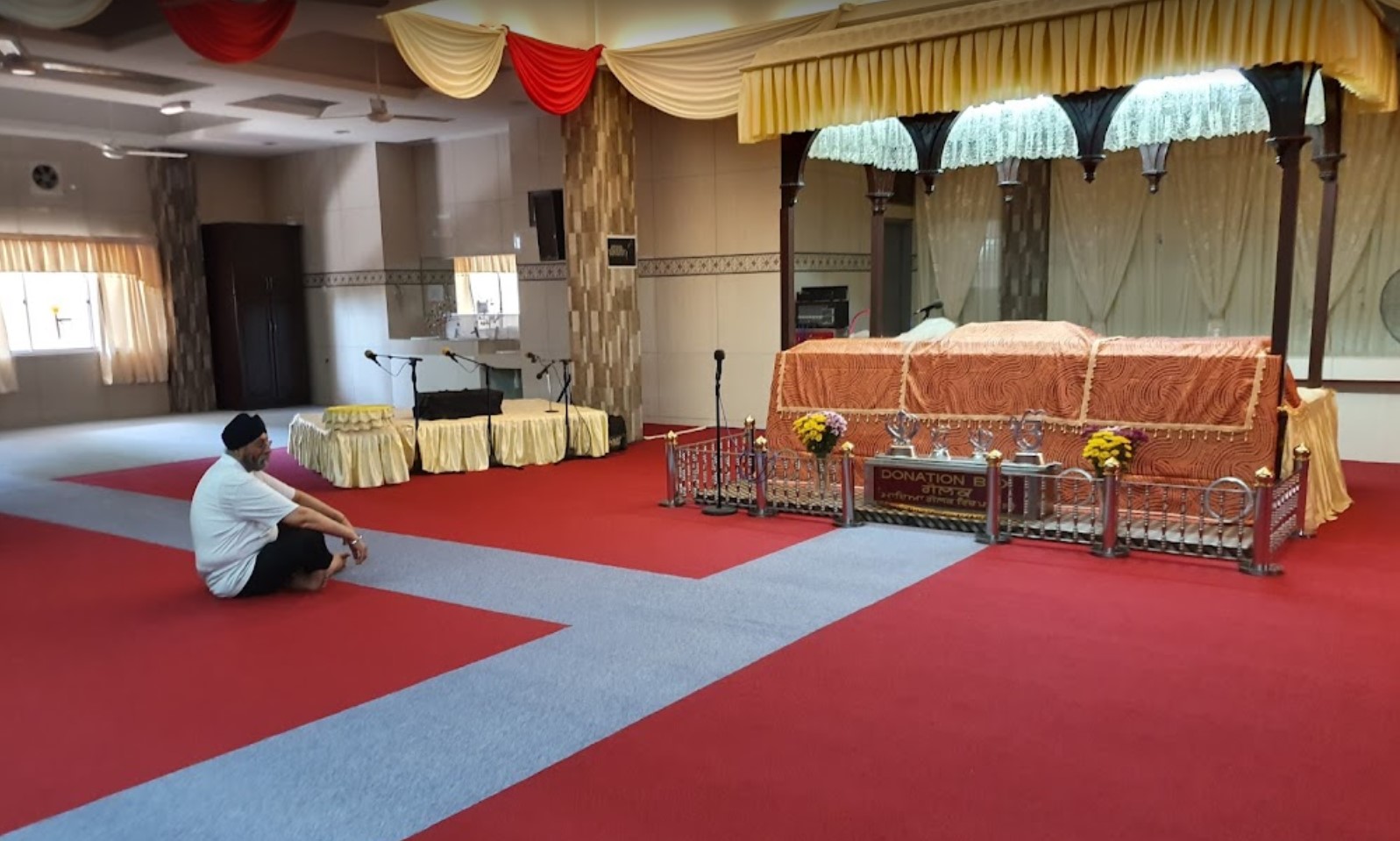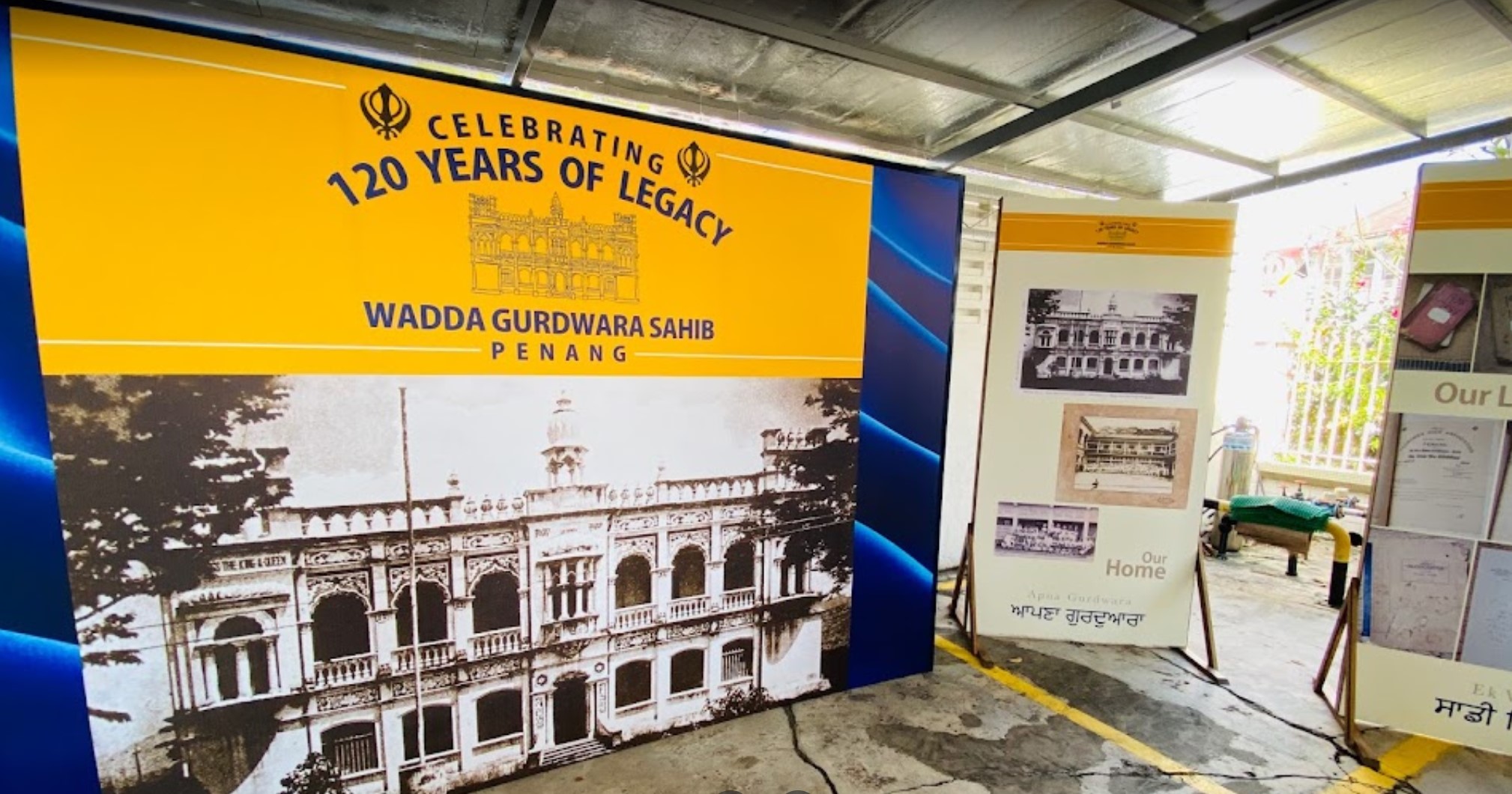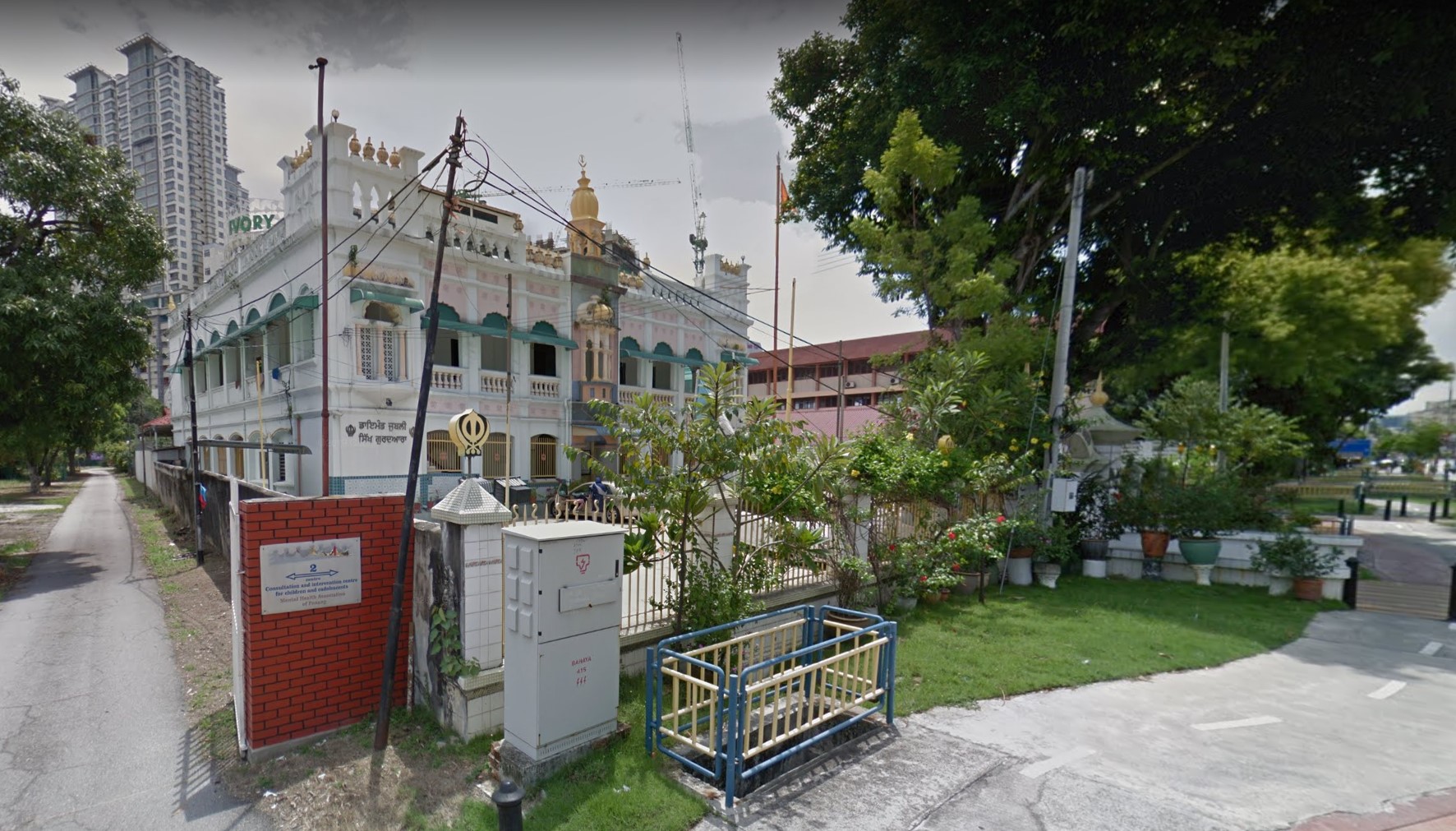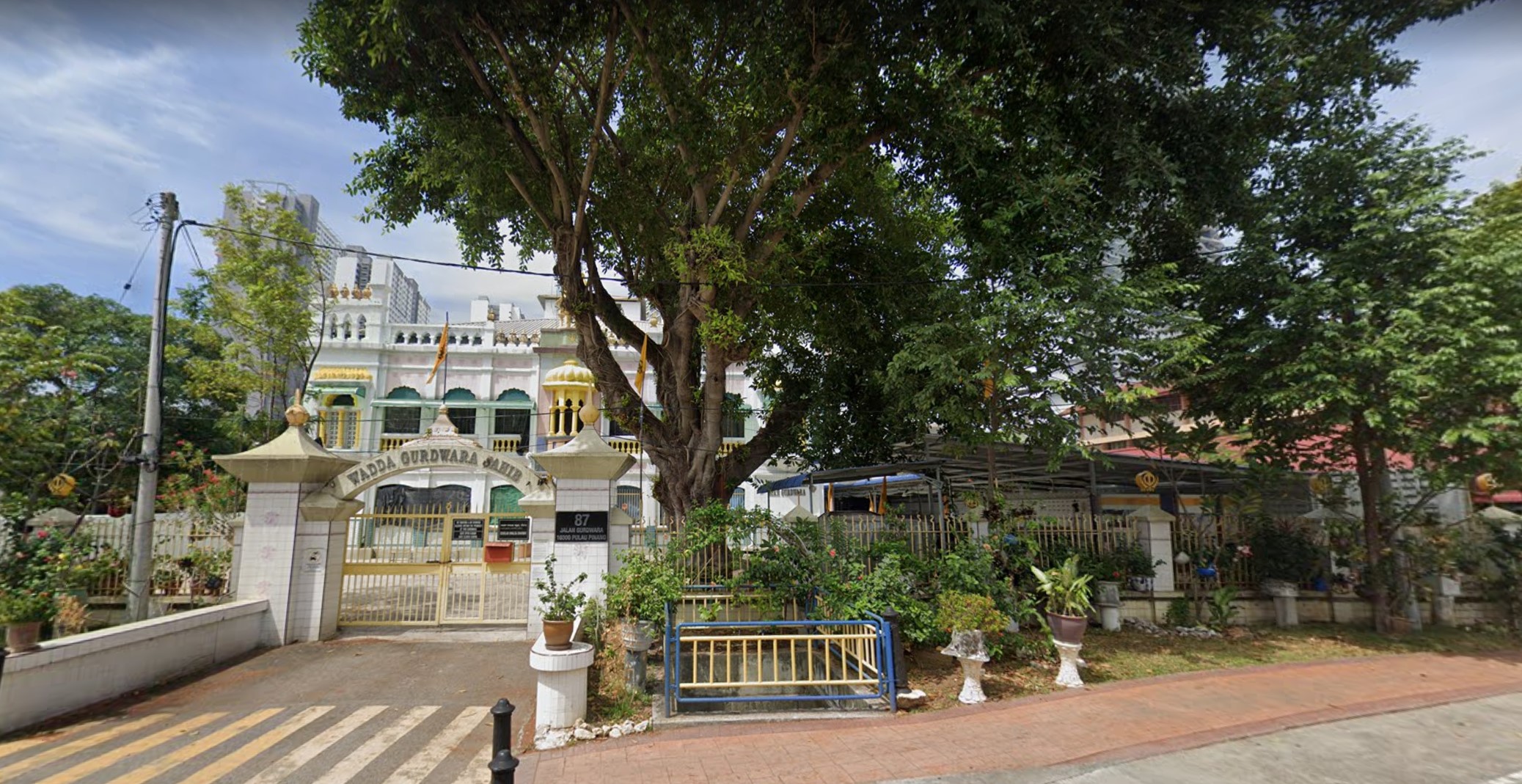Wadda Gurudwara Sahib, Penang
By the 1880’s, there was a large community of Sikhs in Penang mainly in the Straits Settlements Police Force. Some of the Sikhs were employed as watchmen or were dairy farmers.
In 1881, there was one contingent of Straits Settlements Police stationed at Fort Cornwallis, Penang where the Sikh police personnel had their own Gurdwara Sahib. The Malay States Guides (1896 – 1919), which consisted of many Sikh police from the disbanded First Battalion Perak Sikhs (1884 – 1896), also had their own Gurdwara Sahib at Sepoy Lines, Penang by 1896. Both these Gurdwara Sahibs were meant for use by Sikh Police personnel. Sikh civilians had very limited access to these two Gurdwara Sahibs due to security reasons.
Towards the end of the 19th Century, Penang had become a major transit centre for Sikhs arriving by ship from India and travelling onwards to the Malay States, Singapore, Siam (Thailand), Acheh in Sumatra and even British North Borneo and Sarawak. Most of these Sikhs used to stay in Penang for a few days catching up on the latest news. The need for a Gurdwara Sahib for these Sikhs to pray and rest, was acutely felt.
The Diamond Jubilee celebrations of Queen Victoria’s reign were celebrated on a large scale in Penang in June 1897. Dr Sunder Singh, an educated Sikh Veterinary Inspector, joined other Sikhs at the Fort Cornwallis Gurdwara Sahib and read a congratulatory message addressed to “Her Most Gracious Majesty Victoria, Queen of Great Britain and Ireland and Empress of India…In commemoration of the 60th anniversary of your Majesty’s reign, we have decided to erect a temple in Penang which will be designated the Diamond Jubilee Sikh Temple.”
On 25′ June 1899, a committee was set up to raise funds to build the new Gurdwara Sahib building. E.A. Gardiner, the Chief Police Officer in Penang was elected its President, Sardar Gurdit Singh its Vice President, Dr Sunder Singh its Secretary and Sardar Hazara Singh its Treasurer. Every Sikh in the police as well as the Malay State Guides contributed one month’s salary towards the building fund.
In November 1900, the Penang State Government allocated a free grant of a piece of land, 20,064 square feet in size in Brick Kiln Road to build the new Gurdwara Sahib. The names of the first two Trustees in the Title Deed were that of Mr. Gardiner and Mr. MacArther. Subsequently, the names of three Sikh Trustees were also included in the Land Grant as Trustees; Sardar Sunder Singh, Subedar Gurdit Singh and Jemadar Bhola Singh. The indenture document for the Title Deed was si ned between the Penang Government and the Trustees on 23rd March 1901.
On 20th March 1901, the committee of the Gurdwara Sahib decided to invite Colonel R.S. Frowd Walker C.M.G., Commandant of the Malay States Guides (and later British Resident of the State of Perak), to lay the foundation stone of the Diamond Jubilee Gurdwara Sahib building. The date selected for this event was 3rd June 1901, the occasion being the birthday of the sixth Guru of the Sikhs, Sri Guru HarGobind Sahib Ji.
Colonel Walker traveled from Taiping in the State of Perak and arrived at the Penang jetty on the morning of 3rd 1901. He was welcomed by a large gathering of Sikhs which had never before been seen in Penang. He was taken in a procession led by the Malay States Guides band followed by Mr. E.A. Gardiner and Dr Sunder Singh. The Holy Book, Sri Guru Granth Sahib Ji, was carried on a gaily-decorated carriage with Bhai Gujar Singh, a staunch Singh Sabha member in attendance. This was followed by Jathas from various places in Malaya such as Singh Sabha Kulim, Perak Sikhs, Penang Sikh Police and Singh Sabha Penang. Each Kirtan Jatha was led by singers and musicians with dholak (drum) held with straps around the neck, shainai (cymbals), chamtas (a pincer like instrument with small cymbals attached to the sides). This was the normal practice in those days in processions and welcoming parties. The soldiers of the Malay States Guides and the Straits Settlements Police added colour to the parade, which numbered close to 400 men.
The procession wound its way from Fort Cornwallis, through Beach Street, Chulia Street, and Penang Road and finally ended at the site of the Gurdwara Sahib in Brick Kiln Road. The Holy Book, Sri Guru Granth Sahib Ji, was respectfully carried from the carriage and placed on a raised dais. Sardar Sunder Singh read the hukam-naina (Guru’s message) and performed the ceremony of consecrating the Guru Granth Sahib. Speeches were made by various dignitaries followed by Guru Ka Langgar for lunch. Colonel Walker laid the foundation stone of the new Gurdwara Sahib building with a trowel made of solid silver. In addition to the Sikh Sangat, there was a large gathering of European dignitaries present during this occasion. This reflected the high esteem accorded to the Sikhs by the European population at that time.
The Gurdwara Sahib’s two-storey building was completed by the end of January 1903. It is a beautiful piece of traditional architecture. The walls have concrete arches resting on steel girders supported on brick piers. At the centre of the first floor is a skylight roof, over which is situated the inner dome, where on a raised dais the Holy Book, Sri Guru Granth Sahib Ji, is placed. The Gurdwara Sahib was extensively adorned with raised flower motifs and arches. Four staircases, one at each corner, lead to the Darbar Sahib. The Darbar has 16 doors on the three sides and one main door in front, all of which open onto a covered gallery. The cost of construction of this Gurdwara Sahib came to Straits Settlements $22,000.00, which had been donated by Police personnel and the Sikh Sangat.
The date of the grand opening ceremony of the Gurdwara Sahib was fixed for 13th April 1903 being Vesakhi, the day the Khalsa was established. Mr. Charles Walter Sneyd Kynnersley, the Resident Councillor of Penang, was invited to declare the Diamond Jubilee Sikh Temple officially open. This was another impressive event in the history of the Gurdwara Sahib.
At 8.30 a.m. on 13th April 1903, a large number of Sikhs gathered at the Chinese Town Hall. The Holy Book, Sri Guru Granth Sahib Ji, vas conveyed in a phaeton pulled by a pair of horses and guarded by four jamedars with drawn sw–ords. Accompanied by the Penang Police Band, the procession winded its way to Brick Kiln Road. On reaching the Gurdwara Sahib, the Holy Book, Sri Guru Granth Sahib Ji, was taken to the first floor and placed on a decorated semi-circular dais. Bhai Gujar Singh was appointed the Granthi of the Gurdwara. Several hymns were sung followed by prayers and speeches.
At 4.30p.m.in the afternoon on 13th April 1903, the Honourable Resident Councilor, Mr. Kynnersley arrived at the Gurdwara Sahib. The Trustees, Sardar Sunder Singh and Mr. H.O. Newland received him. Sardar Sunder Singh gave a speech on the background and events that led to the completion of the Gurdwara Sahib and the many people who played an important role in its formation. Mr. Kynnersley in his reply thanked everyone present for inviting him for the inauguration of the Gurdwara. He was glad to say that the Sikhs were a very loyal section of British subjects and that the late dear Queen Victoria had the Sikhs interests in her mind and always had a kind word for them. Mr. Kynnersley than declared the building open after which he was taken on a tour of the Gurdwara Sahib. He left the premises after inspecting the building and partaking of light refreshments.
In 1908, the Gurdwara Trust Board changed the name of this Gurdwara Sahib to “Malaya Tapuan Da Gurdwara” (Malaya Territories Gurdwara). As this is the biggest and most historic Gurdwara in Penang, it came to be known as Wadda Gurdwara Penang sometime after 1937.
On 20th February 1925, the adjacent piece of leasehold land next to the Nishan Sahib (flag pole), which is 5,662 square feet in size, was also acquired by the Management Committee.
The annual meeting of the Khalsa Diwan Malaya was held in Penang in 1913, 1915, 1917, 1919, 1922, 1925 and 1930. Sikh delegates from the Malay States and surrounding countries used to attend these meetings to discuss important matters concerning the Sikhs overseas. This event used to have a carnival type atmosphere with poets, hymn singers, Kirtan Jathas, musicians and religious preachers lending colour to these gatherings.
This Gurdwara Sahib has served the Sikh community very well since its inception. It was a beehive of activity and was always full of visitors, travelers, preachers, musicians and students. Guru Ka Langgar has always been available to all, irrespective of race or creed. Up to about 1955, tickets for the Boustead & Company ships plying between Malaya and Calcutta in India could be purchased at this Gurdwara Sahib office.
Sporting teams or groups would stay at the Gurdwara Sahib when in Penang. Eminent Sikh scholars, preachers and leaders such as Sant Mani Singh, Sant Teja Singh, M.A., Prof. Ganda Singh, the well-known historian, Prof. Maninder Singh, Dr. Gopal Singh, Sant Fateh Singh, President of the Shiromani Gurdwara Parbhandak Committee (SGPC) have stayed at this Gurdwara. Gurcharan Singh Tohra, President of the SGPC, stayed at this Gurdwara Sahib in 1980. Sant Baba Sohan Singh of Malacca, a highly respected Saint in South East Asia, was always invited to preach his sermons here whenever he came to Penang.
H.H. The Maharaja of Patiala, Yadvindar Singh, came to Penang in August 1941 to boost the morale of the Sikh regiments serving in the defence of Malaya. He made a speech at the Gurdwara Sahib and later a group photograph was taken.
During the Japanese occupation of Penang from December 1941 to September 1945, this Gurdwara Sahib was a sanctuary for many families who had to abandon their homes due to the bombing of Georgetown, first by the Japanese and later by the B-29s of the Allied Forces.
On 3rd December 1916, Dr Jagat Singh, a well known and respected member of the Sikh community, was appointed as Trustee and first Sikh President. Dr Jagat Singh virtually controlled all the affairs of the Gurdwara Sahib. The other Trustees did not play any active part in its management. The Sangat was very happy doing sewa (service) in the Gurdwara Sahib. Dr Jagat Singh was a staunch Sikh and he enjoyed the confidence of the Sikh community of Penang. He served as a Trustee and President of the Wadda Gurdwara Sahib Penang for 40 years until his demise on 25′ December 1956. His son, Mr. Jagjit Singh a lawyer, was elected as a Trustee and President in 1957.
In August 1966, Sant Fateh Singh, President of the Shiromani Gurdwara Parbandhak Committee (SGPC) Amritsar came to Malaysia to seek assistance for his agitation for the creation of a Punjabi language State in India. Sant Fateh Singh accompanied by Sant Baba Sohan Singh Ji of Malacca arrived at the Penang jetty on 23rd August 1966 where they were welcomed by a large group of Sikhs. At the Gurdwara Sahib, Sant Fateh Singh was given a siropao of RM1,100.00. The Young Men Sikh Association of Penang donated RM900.00 for his ongoing struggle for a Punjabi Subha (State).
The 500th anniversary of the birth of Sri Guru Nanak Sahib Ji in November 1969 was celebrated on a modest scale. The Gurdwara was given a new coat of paint and lighted up for the occasion. An athletic meet organised by Sardar Suaran Singh was held at the City Stadium Penang, which drew a good number of participants. A tea party was also held at the E & 0 Hotel Penang, which was graced by Dr. Lim Chong Eu, the then Chief Minister (Ketua Menteri) of Penang and about 300 Sikhs.
In 1979, the new Marriage and Divorce Act came into force. The Management Committee recommended two names to the Government for appointment as Assistant Registrar of Marriages. The request was approved. The Sikh Assistant Registrar officiates at Sikh marriages at this Gurdwara Sahib when called upon to do so.
The first Granthi was Bhai Gujar Singh a staunch Singh Sabha member. He served from April 1903 to July 1904 after which he joined the Khalsa Diwan Malaya. Bhai Bishan Singh was appointed as a Granthi in July 1904: Bhai Gurdit Singh Pava served as a Granthi in the 1930’s. Bhai Hazara Singh Dhunda who in 1937 joined the Khalsa Dharmak Jatha Penang succeeded him. Bhai Kesar Sin2h served as a teacher and Granthi from 1937 to 1942. Giani Dasaunda Singh Mustaq served as a Granthi in the 1950.s. He was a good poet and writer. Giani Harnam Singh Ballabh M.A. served as a Granthi from 1964 to 1973. He was an educated person and well liked by everyone. He taught Punjabi, Gtt rbani and Kit-tan at the Gurdwara and also wrote a few books on Sikhism. Bhai Joga Singh served as a Granthi from August 1970 until his death in February 1976. After him, his wife, Bibi Amrit Kaur, performed the duties of a Granthi.
Giani Darshan Singh, a well educated and knowledgeable person, served as a Granthi from January 1982 to March 1988 and was well liked by the Sikh sangat. Giani Rattan Singh Chela who had been performing the duties of a Granthi since 1989, retired in August 2001.
The Management Committee celebrated the Gurdwara Sahib’s Centenary in early 2001. The Gurdwara Sahib was repaired and repainted for this special occasion. The Gurdwara Sahib building was lit up with floodlights from April to June 2001. One hundred Akhand Paths were done by the Granthi’s and prayers offered for world peace. A sports carnival was held at the Penang Sports Club on 12th and 13th of May 2001 followed by a Big Walk on 27’h May 2001. A grand centennial dinner was held on 26th May 2001 at the Moral Uplifting Society Penang. The finale was a procession held through the city on 2nd June 2001.
The Gurdwara Sahib has ten rooms for Sikh visitors, which must be booked in advance. Other rooms have been allocated to the Khalsa Association, Sikh Naujawan Sabha, Isteri Satsang, the Langgarni (cook) and two ladies who stay in the Gurdwara premises. In addition there are two Granthi’s quarters as well as a library and office.
The Management Committee comprises of the President, Secretary, Treasurer, their assistants and six committee members.
On 15’h June 2002, the Management Committee appointed the following as Interim Trustees in view of their application to register the Gurdwara Sahib under the Societies Act; Sardar Suaran Singh Balia, Dr. Jagjit Singh Dulku, Dr. Barbinder Singh Bhar, Sardar Rajinder Singh and Sardar Harcharan Singh.
There are presently about 400 Sikh families who participate in the religious activities in this Gurdwara Sahib. The regular weekly prayers are held on Sunday morning from 8.30a.m. to 12.00p.m. The Isteri Satsang programme is held on ‘Wednesday from 2.30p.m. to 5.00p.m. Other religious programmes are held as and when required at the request of the Sangat.
The Sikh Naujawan Sabha, Penang Branch also holds about 10 to 12 programmes a year in this Gurdwara Sahib.
(Note: This well researched history has been made possible due to the untiring efforts of Master Malkiat Singh Lopo – Dhaliwal from “Highlights of a Century 1873 to 1973” and Sardar Suaran Singh Balia, current Trustee of Wada Gurdwara Sahib Penang. His book “Wada Gurdwara Sahib Penang Through 100 years – 1901 to 2001” proved to be an invaluable source from which much of the information on the Wadda Gurdwara Sahib Penang has been extracted.)
Courtesy:
Sikh Gurudwaras in Malaysia&Singapore
Saran Singh Sidhu AMN,PNM,FRNS
